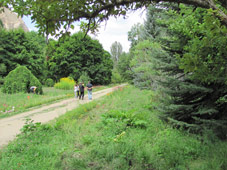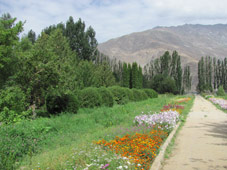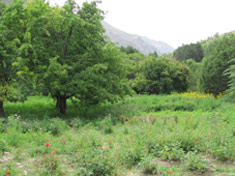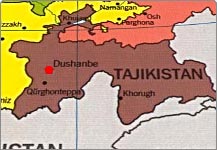Pamir Botanical garden
 | Pamir Botanical Garden bounded by Lombardy poplars is based just 4 km away and over Khorog, on the high terrace between Gunt and Shahdara rivers. Planted at the altitude of 2320 meteres above sea level its only conceded in altitude to Darjiling garden on the south slopes of Himalaya mountains where the climate is warmer and much more humid in comparison with severe Pamiri's climate. |
Garden staff carry out researches over the Badakhshan endemic fruit and ornamental plants, vegetables as well as experiment acclimatizing the foreign plants.
The plants here include: Mulberry, Apricot, Peach, Cherry, Plum, Blackberry, Nut, Apple, Pear trees and even Grapes now bring heavy harvest. Strawberry and Raspberry are also feel good here. Vegetable section includes Cabbage, Potatoes, Cucumbers and even heat loving tomatoes.
| Potatoes were first introduced here only in 1925, despite it originally comes from Central and South America with the same geographical conditions as in Tajikistan - the first harvest was poor with bad quality and taste. Tubers were small like plum and the taste was disgusting. In 1934 seed potatoes were planted to give good results and now planted everywhere in abundance even over 3000 metres above sea level. |  |
There are only 200 vertical metres between Khorog and Garden but it seem enough for fruits and vegetables ripen a week later than the same species grown lower in Khorog. It shows a great influence of natural environment and its specifics for plants rates. At Soviet times were planted willows, poplars, juniper and oleasters. Pamir birch easily distinguished by reddish rind grew up here to a huge size and is widely used by locals for building purposes. Turkestan mountain ash is also can be found here along with wild rose bushes.
 | East Asian Plants like fluffy cherry, some species of east peach trees, apricots and pears feel also good at high altitudes. Ornamental plants include pearlbush. Hundred thousands of sprigs of forest, ornamental and fruit trees were given to Tajikistan farmers to plant and many new spices introduced to this part of Tajikistan since it was founded in 1931. |
These days the garden hosts 2300 spices of high vegetation and has a total territory of 624 ha served as national park.
Home | Travel Basics | Tours | Visa&Formalities | Must See | FAQ's | About us





 Little Pamir 22 day
Little Pamir 22 day




